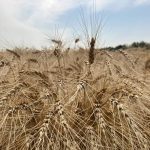1.
Tag Archives grain markets

Near record September major grain deliveries: Statistics Canada
Canadian farmers made heavy deliveries of grains and oilseeds off the combine and into the commercial pipeline this September, with total deliveries of the major crops up 13.3 per cent from the same month the previous year, reported Statistics Canada.

Cycle swings dictate farming profitability
Understanding whether a market is grinding through a major bottom or experiencing a peaking phase can help decisions
It can be profitable to understand where the crop markets are positioned in the context of their big-picture cycles.

ICE Weekly: No upside for canola if China situation continues: trader
Tony Tryhuk of RBC Dominion Securities said canola should stay rangebound if Canada’s trade war with China continues.

Large crops muting upside for soybeans, corn and wheat
Ontario soybean yields better than expected; both Ontario and U.S. corn crops bigger than anticipated
Ontario soybean yields better than expected, both Ontario and U.S. corn crops bigger than anticipated. This is weighing on grain prices.

Prairie Wheat Weekly: Most Western Canadian bids higher
Western Canadian wheat prices were higher on Oct. 16, 2025 compared to the past week.

Several market relationships are out of kilter
We take a look at why extreme positions are being taken in three specific commodity markets and why it matters
There are times when certain markets become cheap while others become expensive. Eventually, these extreme market positions almost always swing to the opposite direction.
CBOT Weekly: Futures rise on multiple factors
Different factors caused crop futures on the Chicago Board of Trade to rise during the week ended Sept. 17, 2025.

Farmtario Markets Desk to give Ontario growers unique insights
Bi-weekly electronic newsletter will augment ongoing curated markets coverage that meets the unique needs of the province’s farm community
Farmtario is launching a bi-weekly markets desk newsletter.

Soybean markets eyes trade talks between China and United States
As the largest importer, China sets the pricing structure for the soybean market
If the U.S. does not make a trade deal with China over the next month, the soybean export projection will be taken down and the ending stocks will swell.

Prairie Wheat Weekly: Wheat bids pressured on multiple fronts
Western Canadian wheat bids were mostly lower during the week ended Sept. 4, 2025 due to weather and potential high yields worldwide.


